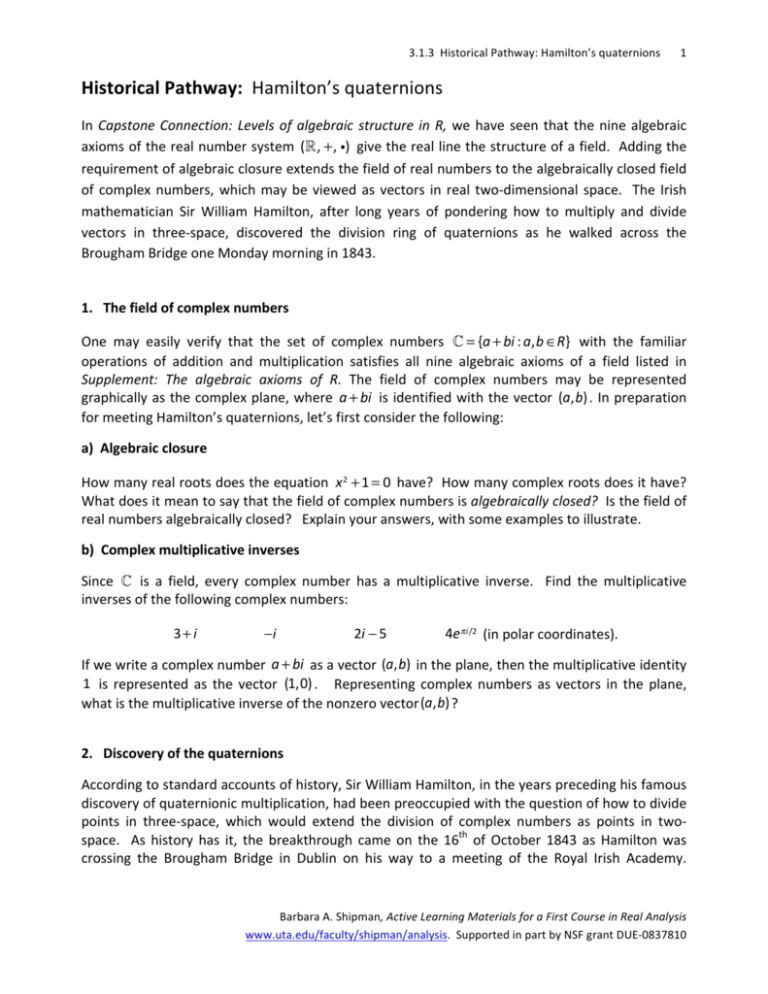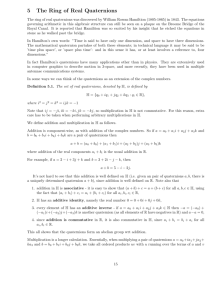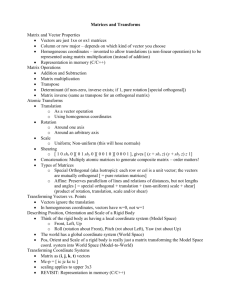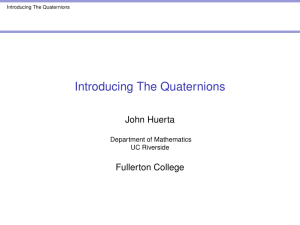Historical Pathway: Hamilton`s quaternions
advertisement

3.1.3 Historical Pathway: Hamilton’s quaternions 1 Historical Pathway: Hamilton’s quaternions In Capstone Connection: Levels of algebraic structure in R, we have seen that the nine algebraic axioms of the real number system (, +, i) give the real line the structure of a field. Adding the requirement of algebraic closure extends the field of real numbers to the algebraically closed field of complex numbers, which may be viewed as vectors in real two-­‐dimensional space. The Irish mathematician Sir William Hamilton, after long years of pondering how to multiply and divide vectors in three-­‐space, discovered the division ring of quaternions as he walked across the Brougham Bridge one Monday morning in 1843. 1. The field of complex numbers One may easily verify that the set of complex numbers = {a + bi : a,b ∈R} with the familiar operations of addition and multiplication satisfies all nine algebraic axioms of a field listed in Supplement: The algebraic axioms of R. The field of complex numbers may be represented graphically as the complex plane, where a + bi is identified with the vector (a,b) . In preparation for meeting Hamilton’s quaternions, let’s first consider the following: a) Algebraic closure How many real roots does the equation x 2 + 1 = 0 have? How many complex roots does it have? What does it mean to say that the field of complex numbers is algebraically closed? Is the field of real numbers algebraically closed? Explain your answers, with some examples to illustrate. b) Complex multiplicative inverses Since is a field, every complex number has a multiplicative inverse. Find the multiplicative inverses of the following complex numbers: 3 + i −i 2i − 5 4eπ i/2 (in polar coordinates). If we write a complex number a + bi as a vector (a,b) in the plane, then the multiplicative identity 1 is represented as the vector (1,0) . Representing complex numbers as vectors in the plane, what is the multiplicative inverse of the nonzero vector (a,b) ? 2. Discovery of the quaternions According to standard accounts of history, Sir William Hamilton, in the years preceding his famous discovery of quaternionic multiplication, had been preoccupied with the question of how to divide points in three-­‐space, which would extend the division of complex numbers as points in two-­‐
space. As history has it, the breakthrough came on the 16th of October 1843 as Hamilton was crossing the Brougham Bridge in Dublin on his way to a meeting of the Royal Irish Academy. Barbara A. Shipman, Active Learning Materials for a First Course in Real Analysis www.uta.edu/faculty/shipman/analysis. Supported in part by NSF grant DUE-­‐0837810 3.1.3 Historical Pathway: Hamilton’s quaternions 2 Rather than restricting himself to vectors in three-­‐space, Hamilton’s insight was to extend the system to a four-­‐dimensional space, as he explains in a letter to his colleague and friend John Graves the following day: “And here dawned on me the notion that we must admit, in some sense, a fourth dimension of space for the purpose of calculating with triples … An electric circuit seemed to close, and a spark flashed forth.” On making this discovery, Hamilton stopped to carve his formula on a stone of the bridge: 2
2
2
i + j + k = ijk = −1 . The set of quaternions H is the set of linear combinations H = {a + bi + cj + dk : a,b,c,d ∈} , which may be represented in vector form by identifying the quaternion a + bi + cj + ck with the vector 4
(a,b,c,d ) in . In addition to its famous multiplication property, quaternions may be added as (a + b i + c1 j + d1k) + (a2 + b2i + c2 j + d2k) = (a1 + a2 ) + (b1 + b2 )i + (c1 + c2 )j + (d1 + d2 )k 1 1
and may be multiplied by real scalars as r(a + bi + cj + dk) = ra + (ra)i + (rb)j + (rd)k for r ∈ . a) Multiplication of quaternions Using Hamilton’s formula for multiplying the basic quaternionic elements i, j, and k, fill in the following table for quaternionic multiplication: x 1 i j k 1 i j k Barbara A. Shipman, Active Learning Materials for a First Course in Real Analysis www.uta.edu/faculty/shipman/analysis. Supported in part by NSF grant DUE-­‐0837810 3.1.3 Historical Pathway: Hamilton’s quaternions 3 Is quaternionic multiplication commutative? Explain your answer from the table. Because of this result, and the fact that the eight other algebraic axioms are satisfied, the quaternions are not a field, but a division ring. Using this multiplication table, together with the distributive property of multiplication over addition, find the product of two general quaternions: (a + b i + c1 j + d1k)(a2 + b2i + c2 j + d2k) = 1 1
b) Division of quaternions In his four-­‐dimensional space of quaternions, Hamilton regarded quaternions of the form bi + cj + dk as pure imaginary, identifying them with vectors in three-­‐dimensional Cartesian space. Quaternions of the form a ∈ with no imaginary part, he called real. By taking multiplicative inverses of pure imaginary quaternions, Hamilton had solved his long-­‐
standing problem of how to “divide vectors in three-­‐space.” What is the multiplicative inverse of a general nonzero quaternion a + bi + cj + ck ? What is the multiplicative inverse of a (nonzero) pure imaginary quaternion? Is the result pure imaginary? That is, if we restrict attention to pure imaginary quaternions, regarded as three-­‐
dimensional space, may we use quaternions to determine how to “divide” two vectors in three-­‐
space? Explain how the algebra of quaternions provides an answer to Hamilton’s search for a way to “divide” vectors in three-­‐space. 3. Square roots of −1 We have seen that over , there are no solutions of the equation x 2 + 1 = 0 and over there are exactly two. How many solutions of this equation are there in H ? Explain how the solutions of x 2 + 1 = 0 in the division ring of quaternions may be viewed as the set of points on the unit sphere in three-­‐space. 4. Applications of quaternions Quaternions are especially useful in describing rotations in space, giving them a prominent role in modern applications such as computer graphics, robotics, signal processing, and control theory. Do a little research into the applications of quaternions, and write a few informative paragraphs about your findings. Be sure to cite the references where you found the information. Barbara A. Shipman, Active Learning Materials for a First Course in Real Analysis www.uta.edu/faculty/shipman/analysis. Supported in part by NSF grant DUE-­‐0837810








